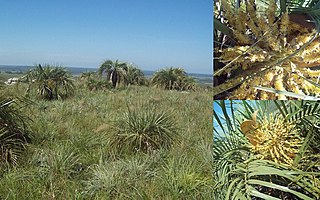
Syagrus is a genus of Arecaceae (palms), native to South America, with one species endemic to the Lesser Antilles. The genus is closely related to the Cocos, or coconut genus, and many Syagrus species produce edible seeds similar to the coconut.

Copernicia alba is a South American species of palm tree, which is found in the Humid Chaco ecoregion in Bolivia, Paraguay, Colombia, Brazil and Argentina. They often, but not always, form dense single-species woodlands. Its common names in Spanish show the various colours that its wood and/or bark takes according to its environment: palma blanca, palma negra, palma colorada. In Guaraní, it is called caranday, "water palm". Its English trade name is wax palm or caranday wax palm.

Butia is a genus of palms in the family Arecaceae, native to the South American countries of Brazil, Paraguay, Uruguay and Argentina. Many species produce edible fruits, which are sometimes used to make alcoholic beverages and other foods. The name is derived from a Brazilian vernacular word for members of the genus.

Syagrus romanzoffiana, the queen palm or cocos palm, is a palm native to South America, introduced throughout the world as a popular ornamental garden tree. S. romanzoffiana is a medium-sized palm, quickly reaching maturity at a height of up to 15 m (49 ft) tall, with pinnate leaves having as many as 494 pinnae (leaflets), although more typically around 300, each pinna being around 50 centimetres (18 in) in length and 3–5 centimetres (1–2 in) in width.

Dyckia is a genus of plants in the family Bromeliaceae, subfamily Pitcairnioideae.

Dipteryx charapilla is a little-known species of flowering plant in the family Fabaceae, a large to mid-sized tree growing along rivers in the rainforests of Brazil. and Peru.

Butia eriospatha is a small species of Butia palm endemic to the highlands of southern Brazil. It is very similar to B. odorata, but is easily distinguished from this species by the distinct spathes which are densely covered in rust-coloured, woolly hairs. Indeed, the specific epithet is derived from Greek ἔριον, wool, and Latin spatha, which refers to the spathe. It has been given the name woolly jelly palm (UK) or wooly jelly palm (US) in English. Vernacular names for it where it is native are butiá-da-serra, butiázeiro, butiá-veludo, butiábutiá verdadeiro, butiá-do-campo, yatáy and macumá.

Butia purpurascens is a smallish, relatively slender, endangered species of Butia palm, up to 3-7m tall. It is locally known as palmeira-jataí, coqueiro-de-vassoura, butiá or coquinho-azedo in Portuguese. The Kalunga people call this palm cabeçudo.

Butia paraguayensis is a species of Butia palm tree found in the cerrado region of South America. Its natural range runs from Mato Grosso do Sul and São Paulo in southern Brazil through Paraguay to northern Argentina and Uruguay. It was given the name dwarf yatay palm in English by 2000, and it is locally known as yata'i in Guaraní in Paraguay, or butiá-do-cerrado in Portuguese in Rio Grande do Sul, Brazil.

Butia capitata, also known as jelly palm, is a Butia palm native to the states of Minas Gerais and Goiás in Brazil. It is known locally as coquinho-azedo or butiá in (northern) Minas Gerais. This palm grows up to 8m. It has feather palm pinnate leaves that arch inwards towards a thick stout trunk.

Butia yatay, the jelly palm or yatay palm, is a Butia palm native to southern Brazil, Uruguay and northern Argentina. It is known as the butiá-jataí in Portuguese in the south of Brazil, as well as simply jataí or butiá. It is sometimes cultivated as an ornamental in Europe and the United States. It is the tallest of all the species in the genus Butia. The fruit is edible with a sweet flavour.

Butia campicola is a very small species of Butia palm with an underground trunk; native to the cerrados of central Paraguay and south-central Brazil.

Butia odorata, also known as the South American jelly palm, jelly palm, or pindo palm, is a Butia palm native to southernmost Brazil and Uruguay. This slow-growing palm grows up to 10m, although it is often less tall. It is identifiable by its feather palm pinnate leaves that arch inwards towards a thick stout trunk.

Butia stolonifera was an oddly growing palm assigned to the genus Butia found only once in Uruguay in the 19th century, but which now is considered to be uncertain as a valid species.
Butia microspadix is a very small species of grass-like Butia palm usually with an underground trunk; native to the states of Paraná and São Paulo in Brazil.

Butia archeri is a small species of Butia palm with a short trunk native to the states of Goiás, Brasília, Minas Gerais and São Paulo in Brazil.
Butia matogrossensis is a smallish species of Butia palm with a trunk of only 0.5 m (20 in) in height or often subterranean, native to the cerrados of the centre, central-east, northeast and likely north of the state of Mato Grosso do Sul, after which it is named, in south-central Brazil. It also occurs in neighbouring south-central Goiás to the north. It is endemic to Brazil, occurring only in this country.
Butia pubispatha is a very small and extremely rare species of Butia palm with an underground trunk; endemic to the east of the state of Paraná in southeastern Brazil.
Butia catarinensis is a mid-sized species of Butia palm native to the states of Rio Grande do Sul, Santa Catarina in Brazil.
Arjona megapotamica is a rare species of flowering plant in the family Schoepfiaceae, native to a small area of southeastern Brazil, where it grows in cool mountain grasslands. Like other Arjona species, it is thought to be a root hemiparasite. It is a small perennial plant growing as a bunch of short twigs from a woody central knob. As of December 2021, Arjona schumanniana was regarded by some sources as a synonym, by others as an independent species.














